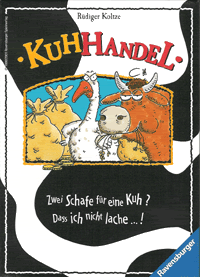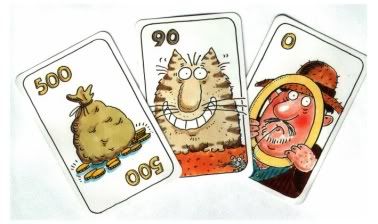1. (n) A trade of horses (accompanied by much bargaining)
2. (v) Trade accompanied by much bargaining and concession
There are only four horses in the game of Kuhhandel, but horse trading pairs with open auctions to drive this seemingly simple game from Rudiger Koltze.
Players have a hand of cash which they try to parlay into complete four-card sets of animals. This is done by buying the animals at auction, or by offering other players a trade of cash for their animals. The cash offer is blind, so you don’t quite know what’s being offered to you other than how many cards comprise the bid. Since the values of money cards scale from zero to 500, that’s not an easy task.

Kuhhandel is published by Ravensburger, with the English edition titled “You’re Bluffing”. The game’s 95 cards are standard-sized for this kind of game, and linen-finished, which I always greatly appreciate. These cards can take a beating, and they’re a pleasure to handle. The game is packaged in a simple tuck box that will wear out faster than the cards. The art of the game is cartoonish and humorous, which is sort of puzzling. It conveys that the game shouldn’t be taken seriously, and it’s rated for 8+ years old, which equates to a kid’s game. This isn’t a kid’s game. Precociousness aside, bluffing is a subtle mechanism that even early teens might have trouble with. Anyway, taking the graphic design decision at face value, it’s merely adequate. Overall, the game package is a bit lacking in presentation, but not in quality.
The Game
The object of the game is to complete as many sets of four animals as possible, with as high a value as possible. There are ten kinds of animals, with values ranging from the scrawny 10-point chicken to the studly 1,000-point horse.
Players start with a hand of money cards that includes a couple of zeros, four tens, and a 50. The 40 livestock cards (or I guess I should say animals since I don’t think dogs and cats qualify as livestock) are shuffled together into a draw pile. A start player is determined and the game commences.
On his turn, a player may either draw an animal from the deck and auction it off, or begin a horse trade by making a sealed offer for an animal type owned by another player.
The auction is a simple, open-ended affair, with players verbally bidding for the animal card drawn and revealed. The auctioneer may not participate in the bid. Once a high bid is determined, the auctioneer may match that bid and take the animal for himself, or accept the bid and give the animal to the highest bidder. The winning bid is paid to the auctioneer. There’s a twist – no change may be made, so if you bid an amount lower than what you can manage from your money cards, you pay the higher price.
There’s a special animal in the game – the “golden donkey”. When the first one is turned up to be auctioned, each player immediately receives a $50 money card. The second donkey to appear yields a $100 card to each player. The third one gives out $200 cards, and the final one $500 cards. This is the only time the money supply in the game changes.

Alternatively, a player may begin a horse trade. If the player has an animal also possessed by another player, he may try to trade for the animal. (You can’t trade for something you don’t already own at least one of.) If you have two of the animal, and the target player also has two, the trade is for both copies of the animal. The player opens the trade by choosing any number of money cards from his hand and offering them to the target player face down. The target player then has a choice: accept the money and surrender the animal, or make a counter offer. If he accepts, he takes the money into hand without showing anyone else what the bid was, and gives the offering player the animal card(s). If he chooses to make a counter offer, he likewise chooses money cards from him hand and places them on the table face down. The players both then reveal their offers to all players. The player who made the higher bid takes the animal card(s) of the other player, and the players take each other’s offered cash.
In a macabre twist, the tied offer rule makes the active player repeat the blind offer, and the target player repeats his counter offer. If the bids are identical a second time, the active player gets the targeted animals for free.
Players continue to auction off animals and make horse trades in turn until all 10 sets of 4 animals have been completed. At that point the game is over.
A player’s score is determined by totaling the value of his animal types, and multiplying that by the number of completed animal sets he has. The player with the highest point total wins!
Strategy
The auction is simple. Just be aware of the no change restriction when bidding. The interesting part of Kuhhandel is the horse trading. Since each player begins the game with two zero value money cards, it’s not easy to determine what’s being offered to you in a horse trade. This is why it’s important to pay attention when players bid, or get into a counter offer situation, since the money flow becomes visible at these points. The golden donkeys serve to make the game a bit harder by introducing very high value cards into the mix. So, there is a memory component to the game, but it’s not really easy to have perfect information since uncountered horse trades are hidden.
In a counter offer, keep in mind that whatever you offer is money you lose if you don’t win the horse trade. If you just kept your cash and took the offer you’d have ended up ahead. So, if you really think that the offer is legit, take the cash without countering. If you’ve been passed a bunch of zeros and tens, well, the game IS called “You’re Bluffing”.
In the end, it’s all about the high value animals. The horse is a potential game-breaker, since combines with one of the mid- to high- value animals, it provides a very strong chance of victory with just two sets. Even paired with the lowly chicken, the horse’s 1,000 points is still formidable.

Reviewer’s Tilt
This was a game that exceeded my expectations. It looked like a nondescript filler card game in a rather plain package which appeared to be targeted towards children. Looks were deceiving. Or perhaps the marketing department screwed up.
Kuhhandel does quite a lot with 40 animals and 11 money cards per player. Its basic mechanisms are set collection, open auctions and double-blind trading, but the result in this case seems to greater than the sum of the parts. There’s more than meets the eye going on when horse trades start being offered, accepted and countered. However, the game does take significantly more time than the 30 minutes indicated on the box. It can drag on up to 90 minutes or more since there are 40 animals to be auctioned off, and you can count on around 20 horse trades in a four player game. As mentioned earlier, I wouldn’t try to play the full game with eight year olds – the auctions and trades would be too much for them to handle.
Kuhhandel does have a “short game” variant in the rulebook, where four animal cards are randomly dealt to players. This random deal can be significant if a couple of horses are dealt to one player. However, this can be fixed by restricting the animals dealt out to the ones under 500 in value. (You can even have fixed sets of starting animals with approximately equal values, assigned randomly.)
To cut down even more time, animals can be auctioned off in lots of two, maybe even up to four if you’re in a hurry. This cuts down the time spent in the auction, focusing the game on the more interesting part – the horse trading.
Kuhhandel feels like a middleweight game, even when player with the fast start rules. There are tough decisions to be made in horse trades, and the auctions aren’t always easy with the limited money supply and the restricted denominations. I like the tension in the game, and the bluff dynamic. That’s rather unusual for a card game, and exceptional for a card game that looks like Kuhhandel does. For the price, which is surprisingly cheap, Kuhhandel certainly deserves a look if your play group likes auctions and games that involve bluffing.
No comments:
Post a Comment